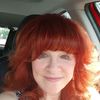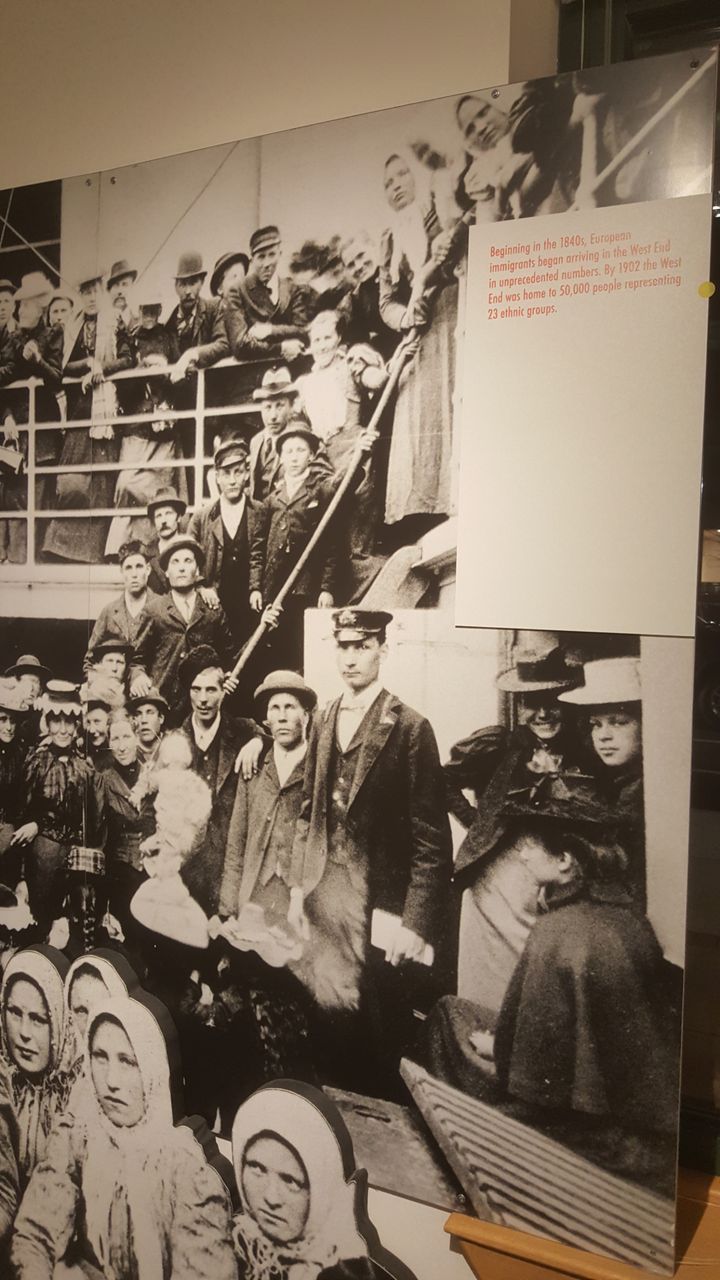
Display on immigrants of the last century at the West End Museum, Boston
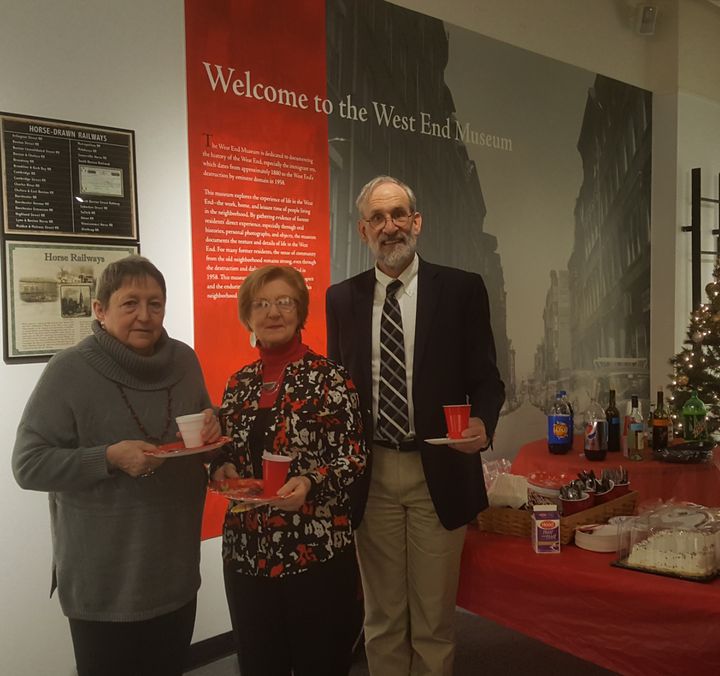
Museum Director Susan Hanson, attendee Una McMahon, and board member Bill Kuttner at the West End Museum holiday party.
Actor Leonard Nimoy, media magnate Sumner Redstone, singer Buddy Clark, and film icon Joseph E. Levine, whose involvements as a producer, distributor or financier included The Lion in Winter, The Night Porter, The Producers, The Graduate and Carnal Knowledge, hailed from the same, near mythological, once-upon-a-time Boston neighborhood.
"We weren't Jews, we weren't Italians, we weren't Irish or any of the 20 other nationalities who lived in the neighborhood," said Bob Andrews. "We were all West Enders."
It was indeed a vibrant and uniquely harmonious center of immigrant life in Boston until the late 1950s, when the West End, its multi-ethnic community, and its tenement-filled streets, shops, smells and sounds fell victim to the bulldozers of the Boston Redevelopment Authority.
They called it urban renewal, but for West Enders, who were largely poor but never knew it, the razing of their section of the city was nothing less than the destruction of what many term "the best neighborhood this side of Heaven." For those still alive today, it will always be as if it happened yesterday.
"The West End had a huge impact both in Boston and throughout the country and, in some cases, throughout the world," said Joe Greenberg, who grew up on Charles Street next to where the former settlement center Elizabeth Peabody House still stands.
Although the West End still exists geographically, with Beacon Hill to its south and the North End to its east, its modern-day highly valued residences and buildings, which include Charles River Park and Massachusetts General Hospital, stand in the starkest of contrast to the down to earth, bustling and hardscrabble street culture of yore.
The 1950s-1960s redevelopment of Boston neighborhoods also included parts of the South End and the notorious Scollay Square burlesque mecca (today, the concrete, Brutalist style Government Center complex). Between 1958 and 1960 alone, one third of Boston’s downtown area was demolished. Enabled by federal funding from the government's Housing Act of 1949 and enticed by the prospects of increased future tax revenues, the BRA, and the Boston Housing Authority (BHA) that preceded it, particularly focused on neighborhoods that were deemed slums.
But ask any former West Ender, be they Armenian, Greek, Irish, Italian, Jewish, Lebanese, Lithuanian, Polish, Russian, Syrian or Ukrainian, and the word slum is like a knife to the heart.
Andrews volunteers at The West End Museum, which according to its website is "a neighborhood museum dedicated to the collection, preservation and interpretation of the history and culture of the West End of Boston." A caption on a museum exhibit states that immigrants began flooding its streets in the 1840s; by 1902, the neighborhood was home to approximately 50,000 people who hailed from some 23 different nationalities.
The West End Museum was first conceived in 1989 by editors of the West Ender Newsletter, a publication founded in 1985 and filled with the first-hand memories of former residents.
In 1991, along with members of the West End Historical Association, they created a Community Development Corporation (CDC) called the Old West End Housing Corporation (OWEHC). West End Place, at 150 Staniford St. on the edge of the old neighborhood and adjacent to Boston's North End, was subsequently given to the group to establish both affordable housing for displaced former West Enders, and a West End visitor center. In 2003, the Bostonian Society moved its “Last Tenement” exhibit on the Old West End, which had previously been displayed in the Old State House, to the premises. In 2010, members of the OWEHC and former West End residents initiated a permanent 501(c) 3 non-profit, The West End Museum, Inc.
Today the Museum, which is free of charge to visit, stands around the corner from Staniford at 9 Lomasney Way, named for the colorful former late 1800's-mid 1950s state senator, state representative, alderman and unofficial Ward 8 political boss Martin Lomasney, whose sculpture and exhibit grace the entranceway to the Museum's main gallery. His infamous credo/advice to budding politicians, “Never write if you can speak; never speak if you can nod; never nod if you can wink,” is updated on his Wikipedia page by, yes, Eliot Spitzer, to include, “never put it in email.”
And it was there where, at a reception last September for an exhibition on the history of urban renewal, Boston Redevelopment Authority director Brian Golden officially, and finally, apologized for the injustice that his agency had committed six decades prior.
In addition to the permanent “The Last Tenement,” the Museum's two additional galleries feature six annual rotating exhibits. According to its website, previous exhibits have included West End photographs from the archives of the Bostonian Society; "The Boston Canal," an extension of the Middlesex Canal through Causeway Street in the Bullfinch Triangle to Haymarket Square; and "Twenty Five Years of the West Ender Newsletter."
The Museum also hosts regular lectures, receptions, ethnic heritage nights, and special events such as the annual holiday party that the HuffPo found itself at on Wednesday evening.
Curator Duane Lucia milled about with tour guides, archivists, board members and visitors. "It all requires a significant commitment on the part of many people to invest their time to keep this kind of Museum successful," said Greenberg.
Among them are Paula Andreattola, Blake Reef, MacKenzie Fraser, lifelong friends Greenberg and Andrews, Ira Tarlin, and Bob Sullivan, who gathered around a table at the party.
About 4 years ago, Reef, who was looking for work, clicked onto volunteermatch.org, thinking he would do some volunteering in the meantime. A native of Natick, Massachusetts, he had not previously heard about the museum, or its mission. "I looked at an exhibit on the history of Leverett Street," he recalled. "What a difference a year makes, and if you look at the photos on the wall, you'll see it," he said, gesturing to a series on the neighborhood before and after the demolition. "I actually wish I had been a part of that, because nowadays, no one gets along as well as they did there," he added.
"There is a seat from the old Boston Garden in the other room," said Fraser. "It just impressed me how big of a change the Garden itself has seen."
Tarlin recalled that his late brother Richard worked with their dad at his business, Eli H. Tarlin Real Estate, which was at 105 Leverett St. "During the seizure of the neighborhood by eminent domain, my brother took photographs of some of the buildings as they were being demolished," he said. About five years ago, Tarlin put the old slides onto a CD, and printed them. They are now part of the Museum's collection.
The party food reflected the rich mixture of immigrants who made up the old neighborhood. Panettone and Italian cookies joined latkes, meat knishes and bagels that Andrews brought from the Butcherie, a kosher supermarket located in nearby Brookline.
"I haven't had this [a knish] since I was a kid," said Andreattola, who is Polish and Italian. "My father, who will be 97 in two weeks and still talks about the West End, lived in the last tenement down the street here," she added, motioning toward what was once Lowell Street.
Andreattola grew up on nearby Chambers Street, where her father relocated the family. "All the relatives were there, but everybody was your relative, really," she said. "Everybody watched out for each other, except once, when someone had stolen my tricycle." But it was back within an hour.
VolunteerMatch also brought in Museum Director Susan Hanson of Boston's adjacent North End. "When I moved to Boston in 2013, I came in to volunteer as an archivist, but someone saw my resume," she recalled. "I'm happy to be here and tell the story of this very diverse, interesting, and interested community,” she continued, noting that it reminded her of her native Pittsburgh, which also experienced urban renewal in the 1960s.
Immigration and the melding of numerous nationalities was only one historic, modern-day parallel drawn that night. Bill Kuttner, a Museum board member and a state transportation planner, spoke with guests about "Dewey Defeats Truman and The Housing Act of 1949," one of the many rotating exhibits that the Museum showcases in order to expand its West End-centered offerings.
"Like the recent election, where it was a foregone conclusion that Clinton would win, then as now, the public can confound the experts," he said. "The 'Do-Nothing Congress,' as Truman deemed them, refused to institute a slum-clearance federal program designed to deal with the housing shortage fueled by returning GIs," he explained.
"But after Truman won his dramatic victory, the Democrats captured both chambers of Congress on his coattails,” he recalled, with a foreboding grimace. “With complete control of Congress, they were then able to enact the Housing Act of 1949, and henceforth, with federal funds available, lead the way for urban renewal projects such as the leveling of the West End."
All Museum exhibits are available in digital format on its website.
During the last year of his life, Nimoy, who never forgot his childhood community, starred in his son Adam's documentary Leonard Nimoy's Boston, which featured the neighborhood and the Museum, which they visited. In the film, Nimoy said that his experiences learning public speaking at the West End House (now located in the Boston suburb of Allston) and in the theater program at the Elizabeth Peabody House, "...set me on a path, which became my life's work."
His sentiments, echoed by many others from the old ‘hood, continue to inspire. And the West End Museum ensures that they won’t be forgotten.
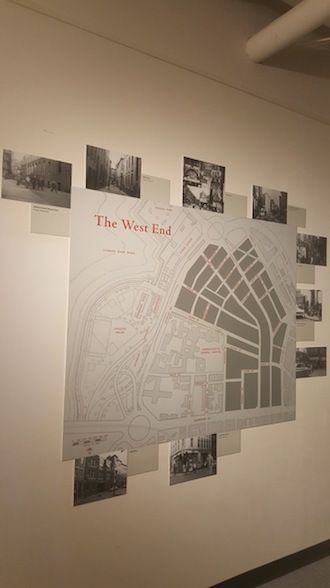
A display of the Old West End at the West End Museum, Boston
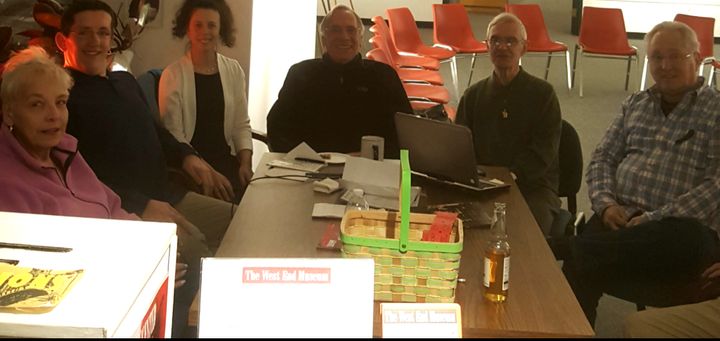
Paula Andreattola, Blake Reef, MacKenzie Fraser, Joe Greenberg, Nob Andrews, Ira Tarlin and Bob Sullivan at the West End Museum of Boston annual holiday gathering
Susie Davidson tweets at @SusieDavidsonMA.
